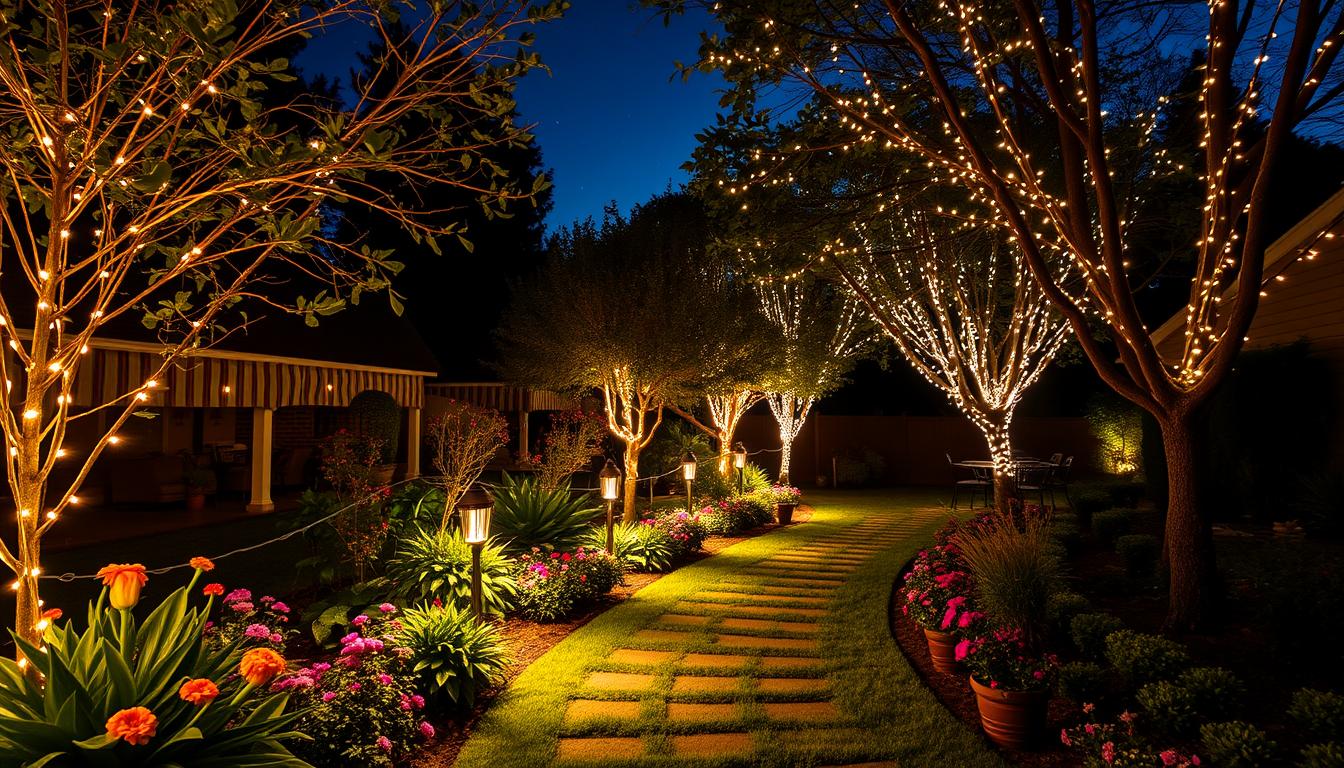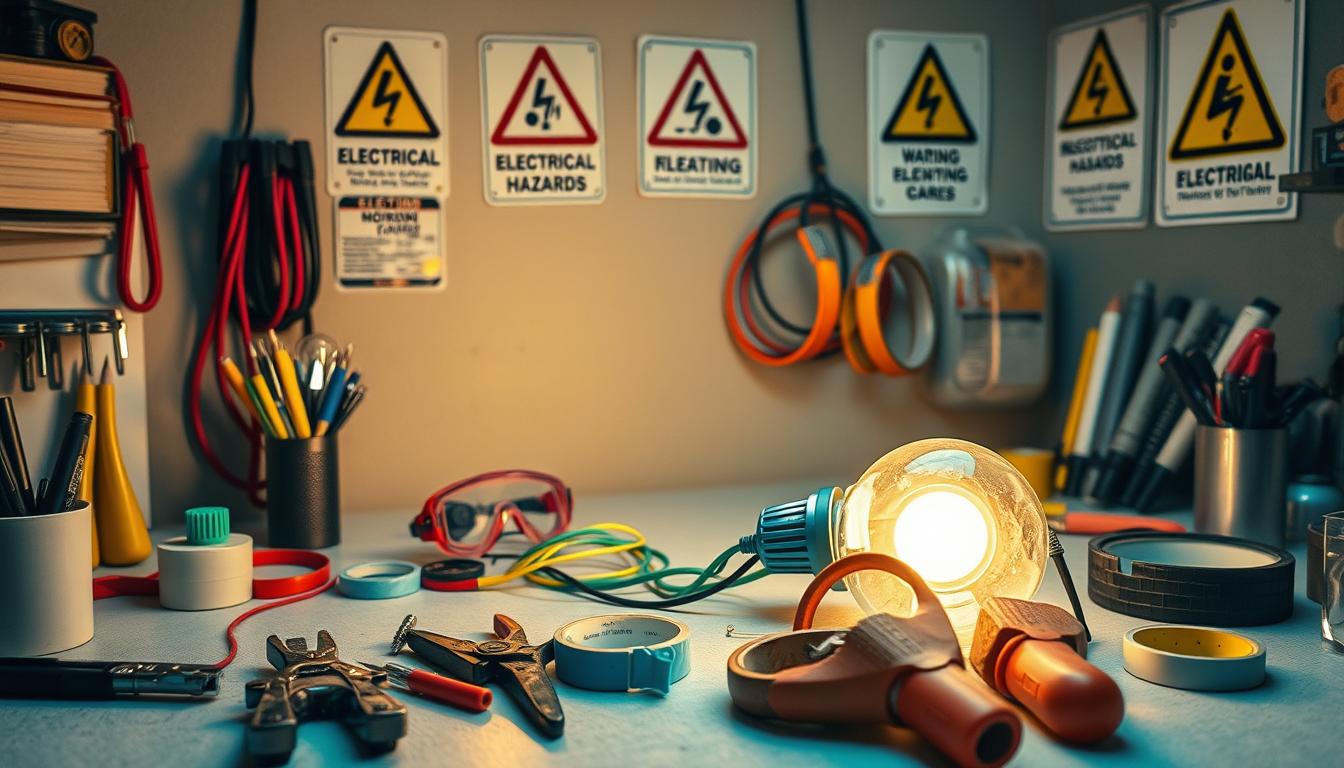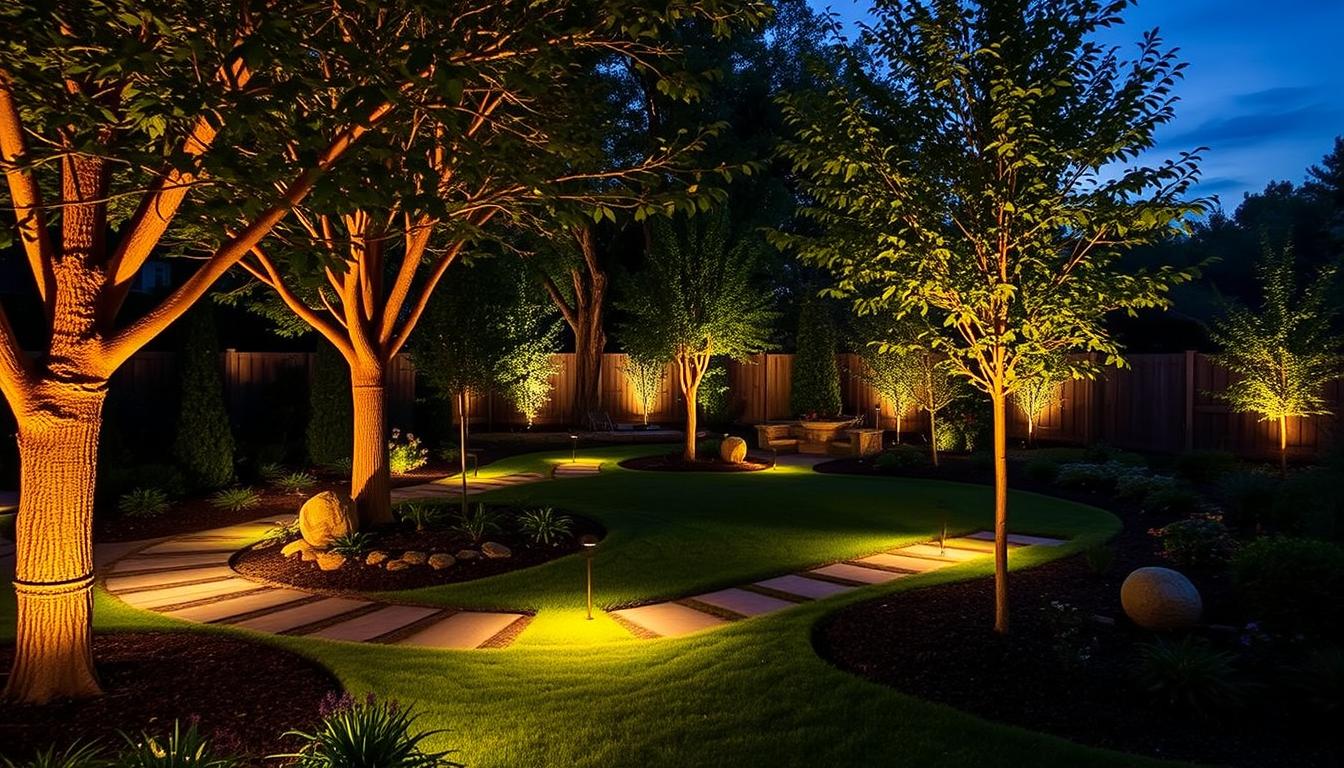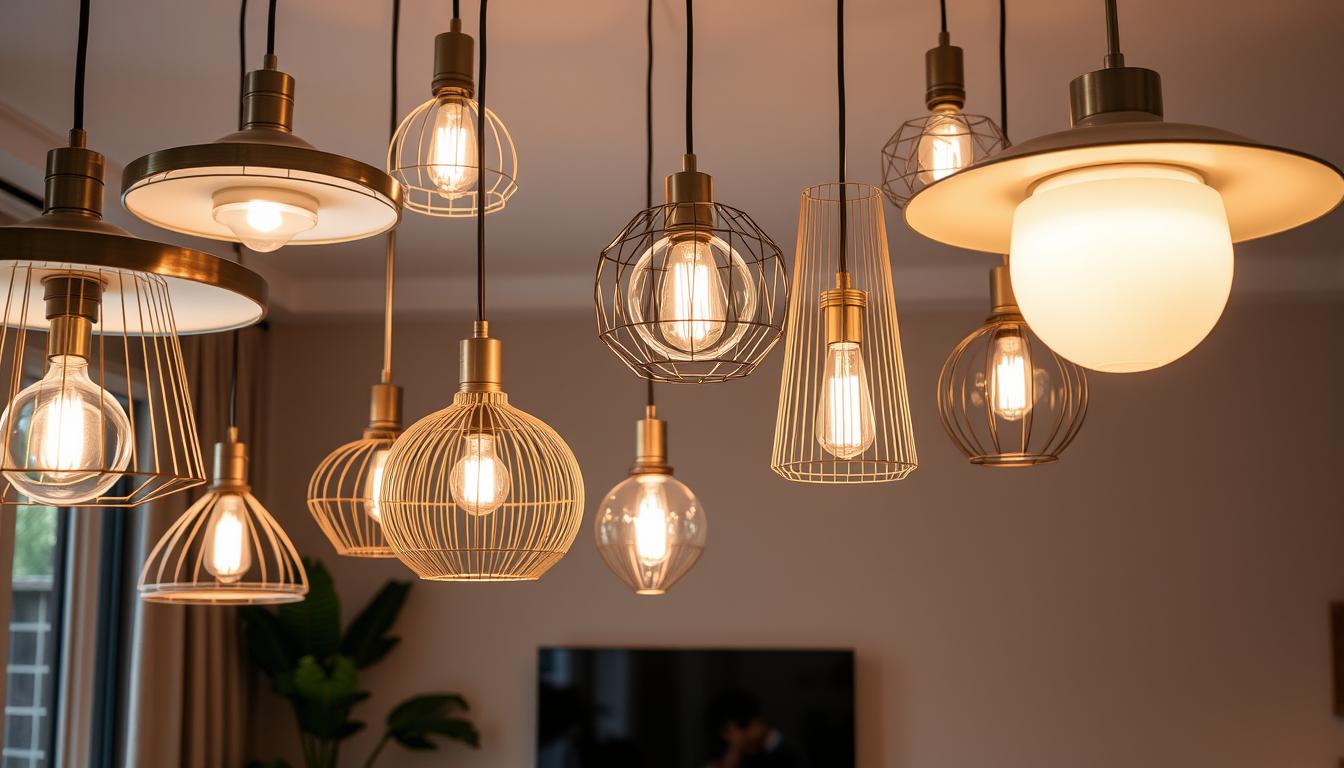Outdoor lighting can dramatically alter the appearance and ambiance of your garden. The right landscape lighting transforms your outdoor space into a serene retreat or a lively entertainment area. Garden lights, a crucial part of outdoor lighting, offer a wide range of styles and designs to match your preferences.
There are numerous options for landscape lighting, including solar-powered and wired systems. Selecting the appropriate lighting ensures your outdoor area is perfectly illuminated. It can accentuate your garden’s features, such as trees, plants, or water features. It also illuminates pathways and walkways.
Landscape lighting serves more than just aesthetic purposes; it enhances safety and security. Installing outdoor lighting can deter intruders and make your home more visible from the street. With the right lighting, you can enjoy your outdoor space at any time, boosting your property’s value.
Introduction to DIY Landscape Lighting
This article delves into DIY landscape lighting, equipping you with the knowledge to create your own outdoor lighting system. We’ll discuss various outdoor lighting types, including garden lights. You’ll learn how to select the ideal lighting for your space.
Key Takeaways
- Outdoor lighting can create a beautiful and inviting outdoor space
- Landscape lighting can provide safety and security for your home
- Garden lights come in a variety of styles and designs
- DIY landscape lighting can be a cost-effective and fun project
- Outdoor lighting can increase the value of your property
- Landscape lighting can be used to highlight specific features of your garden
Understanding the Basics of Landscape Lighting
Lighting design is key to creating an inviting outdoor space. It can transform your yard’s ambiance, making it essential to grasp the basics of landscape lighting. This involves selecting the right outdoor lighting fixtures, such as pathway lights, spotlights, and floodlights, to foster a warm and welcoming atmosphere.
A well-designed lighting system accentuates your yard’s best features while ensuring safety and security. Solar lights are an excellent choice for those seeking energy-efficient and eco-friendly options. They can light up walkways, gardens, and other yard areas, enhancing both beauty and functionality.
Types of Outdoor Lighting Fixtures
- Pathway lights: used to illuminate walkways and sidewalks
- Spotlights: used to highlight specific features, such as trees or gardens
- Floodlights: used to provide overall illumination to a large area
Choosing the right lighting fixture is crucial. It’s also important to consider the available light bulb options and technologies. LED bulbs, for instance, are energy-efficient and long-lasting, ideal for outdoor use. By understanding landscape lighting basics, including design, solar lights, and pathway lights, you can craft a beautiful and functional outdoor space for years to come.
Light Bulb Options and Technologies
Choosing the right light bulb for outdoor lighting can be daunting with so many options. Yet, by focusing on energy efficiency, durability, and cost, you can make a well-informed choice. Popular options include LED, halogen, and incandescent bulbs.
| Light Bulb Type | Energy Efficiency | Durability | Cost |
|---|---|---|---|
| LED | High | Long-lasting | Medium |
| Halogen | Medium | Medium | Low |
| Incandescent | Low | Short-lived | Low |
Planning Your Outdoor Lighting Design
Outdoor lighting design is crucial for creating a beautiful and functional space. Begin by assessing your outdoor area’s size and layout. Also, think about the lighting style you desire. This will guide you in determining the number and type of garden lights needed. For instance, a large patio might benefit from a mix of outdoor lighting fixtures to foster a welcoming ambiance.
Creating a lighting plan is a vital step in the process. It involves deciding on light placement and the types to use. Solar-powered lights are a popular choice for their energy efficiency and ease of installation. String lights also offer a cozy ambiance. When planning your lighting installation, focus on the aesthetic you aim for and the power source.
- Determine the purpose of your outdoor lighting: is it for ambiance, safety, or functionality?
- Assess your outdoor space: consider the size, layout, and features of your yard or patio
- Choose the right type of lights: consider options like solar-powered lights, string lights, or traditional outdoor lighting fixtures
- Plan the lighting installation: decide on the placement of lights and how they will be powered
By following these steps and exploring your options for outdoor lighting, garden lights, and installation, you can craft a stunning and practical outdoor space. This space will be a joy to enjoy for many years.
Essential Landscape Lighting Techniques
Landscape lighting techniques are vital for creating an inviting outdoor space. The right mix of solar lights, wired lighting, and pathway lights can showcase your garden’s beauty. Understanding these techniques is key to achieving a warm ambiance.
Uplighting and downlighting are effective methods for enhancing your outdoor space. Uplighting shines lights upwards to highlight features like trees or statues. Downlighting, on the other hand, creates a warm glow by shining lights downwards. Both can be achieved with spotlights and floodlights, available in solar and wired forms.
Path and Area Illumination
Solar lights and wired lighting are perfect for illuminating pathways and areas. Solar lights are energy-efficient and low maintenance, ideal for pathways. Wired lighting, with its intensity, is better for patios and decks. Combining both types creates a unique and inviting space.
Creating Focal Points with Light
Lighting can draw attention to your garden’s best features. Solar lights and wired lighting can transform your garden into a beautiful space. Techniques like using spotlights on statues or water features and string lights for ambiance are popular.
Solar-Powered vs. Wired Lighting Systems
Homeowners face a choice between outdoor lighting systems: solar-powered and wired. Each has its advantages and disadvantages, impacting your garden lights and lighting design.
Solar-powered systems are ideal for those seeking energy efficiency and cost savings. They harness sunlight, eliminating the need for electricity and reducing environmental impact. Yet, they might not illuminate large spaces adequately and can be weather-sensitive.
Wired systems, by contrast, offer more flexibility and can craft diverse lighting design effects. They are dependable and can shine brighter. Yet, they necessitate a power source and are pricier to install and upkeep.
When deciding, consider these factors:
- Energy efficiency
- Cost
- Maintenance needs
- Design and flexibility
Your choice hinges on your specific needs and preferences. Weighing the pros and cons of each system will help you craft an outdoor lighting setup that beautifies and enhances your outdoor area.
Professional Landscape Lighting Installation Guide
Lighting installation requires a well-thought-out plan to achieve the desired ambiance and safety in your outdoor space. A professional installation can significantly enhance the beauty of your pathway lights, solar lights, and other outdoor features.
To start, you’ll need to gather the necessary tools and materials. This includes wire, connectors, and transformers. It’s vital to choose high-quality products that can withstand the elements and provide reliable performance. Solar lights are a great option as they are energy-efficient and environmentally friendly.
Tools and Materials Needed
- Wire and connectors
- Transformers and timers
- Solar panels and batteries
- Pathway lights and fixtures
A step-by-step installation process is essential to stay organized and ensure success. Begin by planning the layout, digging trenches, and connecting the lights. Always take safety precautions, such as turning off the power supply and using protective gear.
Step-by-Step Installation Process
- Plan the layout and design
- Dig trenches and lay wire
- Connect lights and fixtures
- Test and adjust the system
By adhering to these guidelines and using the right materials, you can create a stunning and functional outdoor lighting system. This system will beautifully showcase your pathway lights, solar lights, and other features.
| Lighting Type | Benefits | Considerations |
|---|---|---|
| Solar Lights | Energy-efficient, low maintenance | Dependence on sunlight, battery life |
| Pathway Lights | Ambiance, safety, and visibility | Placement, spacing, and brightness |
Creating Ambiance with Strategic Light Placement
In outdoor lighting, where you place lights is key to creating a welcoming atmosphere. The right placement can highlight your garden’s best features and set the mood. Use spotlights, floodlights, and pathway lights for a layered lighting effect.
The color temperature and brightness of your lights greatly influence the mood. Warm white lights can make your space cozy and intimate. Cool white lights, on the other hand, can brighten and energize the area. By choosing the right garden lights and placing them thoughtfully, you can craft a stunning outdoor space for both relaxation and entertainment.
- Opt for lights with a warm color temperature for a cozy feel
- Position lights at various levels for a layered effect
- Consider solar-powered lights for energy efficiency and eco-friendliness
By applying these tips and considering your garden’s unique aspects, you can create a welcoming outdoor space. Balance your lighting with your garden’s natural beauty. Feel free to experiment with different designs until you find the perfect fit.
Maintaining Your Outdoor Lighting System
Keeping your outdoor lighting system in good shape is crucial. Regular inspections can catch issues early, preventing bigger problems. Make sure to clean your solar and pathway lights to remove dirt and debris.
A well-maintained lighting system greatly enhances your outdoor space’s ambiance. Solar and pathway lights add beauty and functionality. They make your outdoor area ideal for both relaxation and entertainment.
- Regularly inspect the lights and connections for damage or wear
- Clean the lights and fixtures to ensure they are free from dirt and debris
- Replace bulbs as needed to maintain optimal lighting levels
By following these maintenance tips, your outdoor lighting system will last for years. It will create a welcoming outdoor space for any event.
Smart Technology Integration for Landscape Lighting
Smart technology is transforming outdoor lighting, making it more efficient, convenient, and customizable. Homeowners can now control their outdoor lighting remotely, adjusting brightness and color as needed. This is incredibly useful for garden lights, allowing for easy adjustment to highlight garden features.
The advantages of integrating smart technology into outdoor lighting are vast. It promotes energy efficiency by automatically turning lights on and off, reducing waste and saving energy. It also offers convenience, enabling control from anywhere using smartphones or tablets. Plus, it allows for customization, enabling homeowners to adjust lighting levels and colors to create various moods and ambiance.
Popular smart lighting systems for outdoor use include Wi-Fi and Bluetooth-enabled options. These systems make controlling and customizing outdoor lighting easy, perfect for setting the right mood for any event. By integrating smart technology into outdoor lighting, homeowners can create a unique and inviting space that is both functional and aesthetically pleasing.
- Energy efficiency
- Convenience
- Customization
By considering these benefits and incorporating smart technology into outdoor lighting, homeowners can enhance their living spaces. Whether it’s to highlight garden features or create a warm ambiance, smart technology elevates outdoor lighting to new heights.
Conclusion: Illuminating Your Outdoor Space with Confidence
In wrapping up this guide on DIY landscape lighting, we aim to have equipped you with the knowledge to transform your outdoor area into a stunning oasis. By grasping the basics of outdoor lighting and the art of strategic garden light placement, you’re now ready to craft a visual masterpiece. This masterpiece will not only beautify but also enhance the ambiance of your backyard.
The essence of effective landscape lighting is in mastering various techniques, from uplighting to path illumination. It’s also about harnessing the benefits of both solar-powered and wired systems. With these resources, you can skillfully shape your outdoor space. This will bring out architectural highlights, pathways, and focal points, creating a magical atmosphere.
Remember, the success of your DIY lighting project hinges on attention to detail and a willingness to try new things. By adhering to the step-by-step installation guide and keeping your outdoor lighting system in check, you’ll maintain a welcoming and visually appealing retreat. This will be the case for many years to come.
So, with your newfound expertise, let your creativity flow as you light up your outdoor space with confidence. The possibilities are vast, and the joy of a beautifully lit garden will bring endless delight to you and your loved ones.






